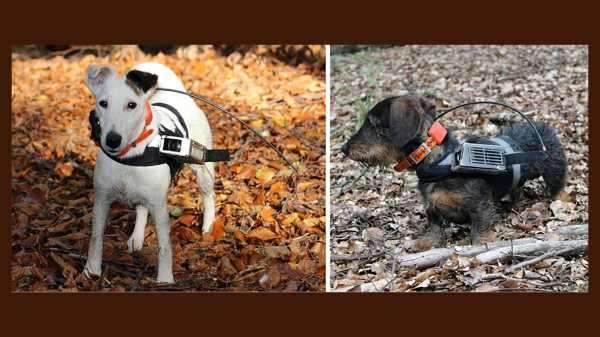
Hunting dogs use more than their noses to find their way back to their owners hundreds or even thousands of feet away, researchers have found. Turns out, these four-legged navigators may sense Earth’s magnetic field and use it as a compass, scientists are now reporting.
This ability, called magnetoreception, is common in many animals, including some whale species, dolphins and sea turtles, among others. Now, a new study carried out in the Czech Republic and detailed in the journal eLife, suggests adding at least some hunting dogs to this list.
“This ‘sense’ is beyond our own human perception and it is, therefore, very hard to understand its meaning for animals,” study researcher Kateřina Benediktová, at Czech University of Life Sciences Prague, told Live Science. Benediktová is a graduate student in the lab of Hynek Burda, another study author.
This work builds on previous research by Benediktová and Burda, along with a team of scientists, who found that several breeds of dog preferred to poop with their body aligned along the magnetic north-south axis. The researchers speculated that behavior could help the dogs map their location relative to other spots, such as their starting point, they said in their study published in 2013 in the journal Frontiers in Zoology, as reported by Science magazine.
In the new study, Benediktová and her colleagues looked specifically at hunting dogs because this group of dogs has astonishing homing abilities that are not fully understood. They have been bred over generations to seek out game and if they don’t find any, they navigate back to their owners over long distances, often using novel routes back. How these dogs pinpoint their owner’s location in densely forested areas is perplexing.
Between September 2014 and December 2017, Benediktová’s team equipped 27 hunting dogs of 10 different breeds, including fox terriers and miniature dachshunds, with GPS trackers. These dogs were allowed to roam in forested areas away from buildings, roads and powerlines. Dogs ran individually and returned on their own. Trips took between 30 and 90 minutes. Owners hid close to the location where the dog was released. The GPS data, from a total of 622 excursions in 62 different locations in the Czech Republic, were then compiled and analyzed.

Here, two study participants, a fox terrier (left) and a miniature dachshund (right), are equipped with a GPS transmitter, an antenna and a camera.
What researchers found was that the dogs mostly followed their own scent to take the same route back as they did on the outbound trek — a method called “tracking.” In 223 of the excursions, however, the dogs took a novel route back using a method referred to as “scouting.” The researchers looked more closely at the GPS data from these “scouting” treks to investigate how those dogs found their way back. A majority of the scouting dogs began their return with a short run along Earth’s north-south axis. The researchers noticed that this “compass run” occurred regardless of the dog’s actual return direction.
“We propose that this [compass] run is instrumental for bringing the mental map into register with the magnetic compass and to establish the heading of the animal,” the researchers wrote in their paper.
Those scouting dogs also returned faster to their owners than the dogs using the tracking method, in which they just came back the same way they went out.
“We were absolutely excited “when we found an unexpected magnetic behavior in the dogs’ scouting return strategy,” Benediktová said. “Hunting dogs roam over large distances. A human would most probably get lost without a compass and a map if roaming over comparable distances in unfamiliar forested areas. In addition, after the north-south compass run, dogs were able to run more directly to the owner.”
Kathleen Cullen, a neuroscience professor at The John Hopkins University who was not involved in the research, said the findings are exciting, “Overall, I think that the authors’ unexpected discovery that hunting dogs will often perform a ‘compass run’ before returning home is exciting — these results will certainly motivate further exploration of how exactly the mammalian brain encodes magnetic cues and then uses this information to achieve accurate navigation.”
Cullen added, “It is also interesting “that these results build on previous findings showing that other animals, such as migratory birds, also sense the Earth’s magnetic field to navigate back to their homes.”
When asked what motivated this study, Benediktová said that “the connection between navigation, homing and magnetoreception could be very close.” In addition, “its role in the orientation of dogs has not been studied as thoroughly as in migratory birds, turtles or subterranean mole rats.”
The researchers also tried to rule out other explanations besides the compass run for how the dogs found their way back to their owners. GPS data from scouting dogs showed no significant performance difference between dogs of different sexes, and dogs navigated back equally well in both familiar and unfamiliar terrain. They also determined that the position of the sun had little influence on the dog’s navigation ability, because most days were overcast. Dogs probably weren’t using distant landmarks to navigate because researchers saw no significant difference in homing abilities of tall and short dogs even though short dogs would be less able to see through the dense foliage. And the team ruled out the possibility of dogs using scent to navigate home because only 10% of the runs had winds blowing in the direction from owner to dog and scouting runs were nearly 100 feet (30 meters) from outbound runs.
In WWI, dogs delivered messages while under fire and they helped locate wounded soldiers and carried first aid kits to be used in the field. The amazing abilities have long been a source of amazement and curiosity. For every generation, there is a heartwarming movie like “Lassie Come Home,” about a dog who can travel long distances. This current Czech study may provide a clue to dogs’ phenomenal abilities.
“The magnetic field,” the researchers wrote in their paper, “may provide dogs with a ‘universal’ reference frame, which is essential for long-distance navigation, and arguably, the most important component that is ‘missing’ from our current understanding of mammalian special behavior and cognition.”
Cullen cautioned that the study needs to be replicated to make a stronger case for the conclusions, but if it is verified, the findings “suggest that a neural strategy in which magnetoreception contributes to the brain’s ‘internal GPS’ is likely to be more common than previously thought.”
Originally published on Live Science.
Sourse: www.livescience.com





